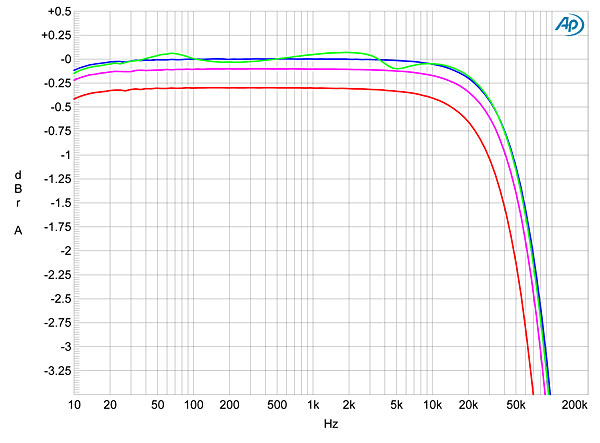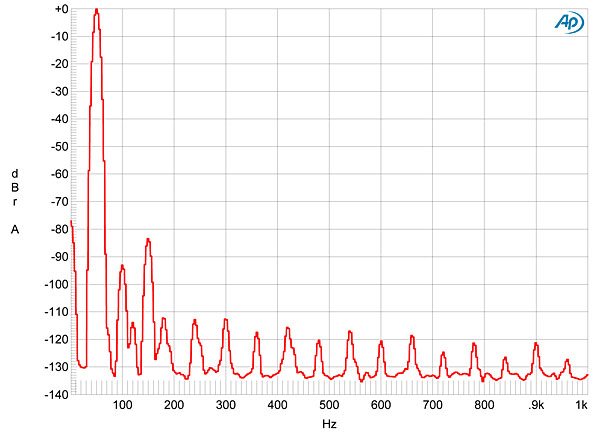| Columns Retired Columns & Blogs |
How can one comment on this .
It's big , it's beautiful , and it's unaffordable .
Great review though Wes .
To perform the measurements on the Luxman B-1000F, I used Stereophile's loan sample of the top-of-the-line Audio Precision SYS2722 system (see the January 2008 "As We See It" and www.ap.com). Before doing the testing, I ran the Luxman at one-third its rated power for 60 minutes, which thermally is the worst case for an amplifier with a class-A/B output stage. At the end of that period, the chassis was only mildly warm.
The voltage gain into 8 ohms was the same from the balanced and unbalanced inputs, and slightly higher than specified: 32.6dB. The switchable 4dB pad dropped this figure by 4.15dB. With the front-panel Phase LED dark, the B-1000F preserved absolute polarity through its unbalanced input but inverted polarity through its balanced input. The XLR jack is thus wired with pin 3 hot, the opposite of the AES standard. The input impedance at low and middle frequencies was close to specification, at 44k ohms unbalanced and 64k ohms balanced. It did drop slightly but inconsequentially at 20kHz, to 34k ohms unbalanced and 60k ohms balanced.
The output impedance was 0.125 ohm at 20Hz and 1kHz, rising slightly to 0.15 ohm at 20kHz. As a result, the modification of the amplifier's frequency response due to the interaction between this impedance and that of our standard simulated loudspeaker remained within ±0.1dB limits (fig.1, green trace). Into resistive loads, the Luxman's ultrasonic response rolled off to reach –3dB just below 100kHz, which resulted in a well-defined 10kHz squarewave (fig.2). The B-1000F was not as quiet as some amplifiers I have tested; its unweighted, wideband signal/noise ratio (ref. 1W into 8 ohms with the input short-circuited) measured 70.2dB. Switching an A-weighting filter in-circuit improved this figure to 82.7dB, which is equivalent to the specified 118dB ref. full power.

Fig.1 Luxman B-1000F, frequency response at 2.83V into: simulated loudspeaker load (green), 8 ohms (blue), 4 ohms (magenta), 2 ohms (red). (1dB/vertical div.)

Fig.2 Luxman B-1000F, small-signal 10kHz squarewave into 8 ohms.
Fig.3 plots the percentage of THD+noise in the Luxman's output against output power. The downward slope of the traces below 50W or so suggests that the figure is dominated by noise. (A constant level of noise becomes an increasing percentage as the output level drops.) The actual distortion is very low, but starts to emerge from the noise with increasing power until the B-1000F actually starts to clip. This graph reveals not only that the B-1000F comfortably exceeds its specified power of 24dBW, but that it behaves close to a true voltage source. At 1% THD+N the amplifier puts out 310W into 8 ohms (24.9dBW), 600W into 4 ohms (24.8dBW), and 1150W into 2 ohms (24.6dBW).

Fig.3 Luxman B-1000F, distortion (%) vs 1kHz continuous output power into (from bottom to top at 100W): 8, 4, 2 ohms.
Though the amplifier's distortion is very low in level, that distortion does increase with decreasing load impedance, as is shown by fig.4, which was plotted at a level (20V) where the THD was above the noise floor. Though the THD+N percentage in this graph does rise in the top two octaves, that rise is mild, suggesting that the circuit has a relatively wide open-loop bandwidth. At low levels the distortion primarily comprises low-order components (fig.5), but at high powers into low impedances the third harmonic predominates, with some higher-order spuriae visible (fig.6). Even so, the absolute level of all the distortion components remains low.

Fig.4 Luxman B-1000F, THD+N (%) vs frequency at 20V into: 8 ohms (blue), 4 ohms (magenta), 2 ohms (red).

Fig.5 Luxman B-1000F, 1kHz waveform at 40W into 4 ohms (top), 0.0062% THD+N; distortion and noise waveform with fundamental notched out (bottom, not to scale).

Fig.6 Luxman B-1000F, spectrum of 50Hz sinewave, DC–10kHz, at 287Wpc into 4 ohms (linear frequency scale).
Finally, the Luxman B-1000F performed very well on the demanding high-power, high-frequency intermodulation test. Even at a level just below visible waveform clipping into 4 ohms, the 1kHz difference component lay at almost –100dB (0.001%), and the higher-order products were still below –80dB (fig.7).

Fig.7 Luxman B-1000F, HF intermodulation spectrum, DC–24kHz, 19+20kHz at 256W peak into 4 ohms (linear frequency scale).
Yes, it's expensive, and yes, it's heavy, but Luxman's B-1000F turned in an impressive performance on the test bench. I'm not surprised that Wes Phillips very much enjoyed his time with the pair of them.—John Atkinson

Great review. I love the clean aesthetics. I had a Luxman D-113D CD player back in the early 90's. It was a great CD player.

A great review puts you in the room with the reviewer. This was a great review. The amp sounded awesome!

I re-read the print review for kicks, and the explanation JA gave was very educational. Seeing the information transition from figs 1 to 2, as well as the generally informative figs 3 and 4, I can see very clearly his references.
I really want that Gabriel tune- it didnt come on the LP!

You can trust Mr. Phillips opinion in the sound of the Luxman. I will never know unless I run accross it at a show or dealer. If it cost as much as some undesirable homes and desirable cars, it should sound better than a great cheaper but fine Parasound Halo. If you don't have a nice car or home, maybe you should not buy it. To me, my system would get more use than my automobile. But singularly height of the amp would cause me to overlook it as if I could acquire it. Though love the way Luxman keeps its guts separated!